| Previous Articles |
International Perspectives - January 3, 2000
Soaring into the new century
Financial Markets
Europe  Several factors are driving Europe's markets upwards. One is the energy unleashed by the single currency. The euro has helped Europe to focus on the single market and has forced companies rethink their strategies. Restructuring, mergers and acquisitions are taking place on an unprecedented scale as a result. At the same time, European equities are becoming fashionable with investors. The European economies are generally healthy. Britain continues to be strong while German and France appear to have recovered from the slow growth earlier in 1999. While Europe's economic performance may still look somewhat anemic when compared with the United States, there are now fewer signs of weakness. The structural changes beginning to take place are providing a unique opportunity for faster economic growth. In London the FTSE broke through the 6900 barrier for the first time ever. The FTSE 100 rose 17.8 percent on the year, with an increase of just under 15 percent in the fourth quarter. Similarly, the CAC soared 51 percent for the year and 35 percent in the fourth quarter. Appropriately, the CAC ended the year with its 38th record high. The DAX rose 39 percent on the year and 33 percent in the fourth quarter. 
Asia 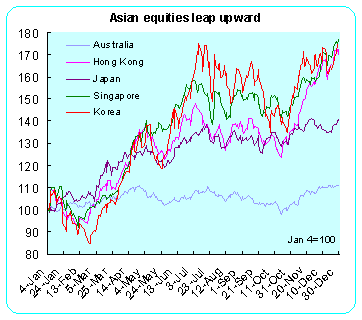 The Nikkei jumped 37 percent to end the year at 18,934.34, its biggest annual gain in 27 years. Foreigners were net buyers of Japanese stocks in the week ended Dec. 17 for the 42nd time in 46 weeks, according to the Tokyo Stock Exchange. Hong Kong saw its own high technology investment frenzy push the Hang Seng index to an all time record and a 69 percent gain for the year. Singapore shook off vestiges of the Asian financial crisis when demand surged for high technology companies. This helped boost the Straits Times index up about 78 percent in 1999. South Korean KOSPI also ended trading at its high for the year. The KOSPI climbed almost 83 percent in 1999. The sky rocketing market reflects the strength of the South Korean economy's recovery from the effects of the 1997 Asian financial crisis.
Americas 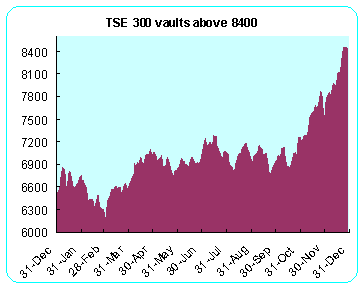
Currencies 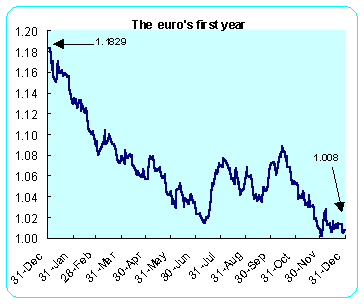 The euro lost 14 percent of its value since its inception a year ago for a variety of reasons. Investors bought euros early in the year because they thought that the U.S. economy would cool off and European markets would perform better. Now with European Monetary Union growth improving and structural problems finally being addressed, the hope is that the euro will improve. However, the attraction of higher returns on investment in the United States and in the United Kingdom (because of higher interest rates) continues to pressure the euro. Traders may find euros more attractive in coming weeks on speculation that the European Central Bank may raise interest rates soon to keep accelerating growth from pushing inflation higher. Higher European rates would narrow the spread between the EMU and U.S. and British rates and make euro denominated deposits relatively more attractive.
Yen 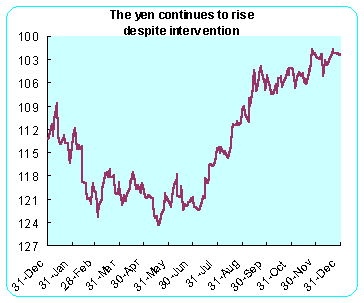 The yen continues to appreciate against the dollar because Japanese exporters repatriate profits from abroad, frustrating the Bank of Japan's intervention attempts to stem the currency's rise. The Bank of Japan has intervened 12 times since June to control the yen's rapid rise. However the drop in the yen hasn't been sustained because Japanese exporters take advantage of the dollar's rally after intervention to sell the dollar for yen. That causes greater demand for yen, rather than the lower demand the central bank wants to achieve. Japan is concerned a stronger yen will wipe out exporters' profits and hurt business and consumer confidence as the country tries to recover from its worst recession since World War II. Japanese companies doing business abroad, particularly in the United States, started out their year estimating the dollar would buy about 115 to 120 yen. The falling dollar has eroded the value of their U.S. sales and forced them to change their currency projections. Indicator scoreboard... November harmonized consumer prices rose 0.2 percent on the month and 1.6 percent on the year. Core inflation - excluding energy, food, alcohol and tobacco - remained relatively subdued, up 0.1 percent in November and one percent on the year. In contrast, the October core rate was up 0.9 percent when compared with last year. EMU inflation continued to pick up because of higher energy prices, which were up 0.3 percent on the month and 7.2 percent when compared with last year. November energy prices were above the 6.4 percent annual rise posted in October and well above the 4.4 percent annual decline posted in November 1998. In addition, four EMU states - Italy, the Netherlands, Spain and Ireland - had annual harmonized inflation rates at or above the ECB's two percent target for all of the EMU. Ireland's HICP rate rose three percent. 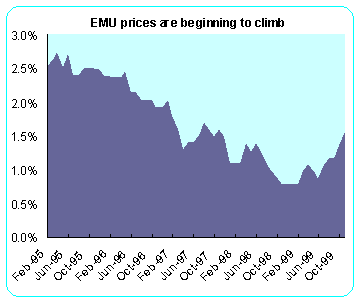 November M3 money supply growth accelerated again when compared to the previous month. The annual rate of growth rose to 6.2 percent, from the revised 5.8 percent in October. The November increase pushed the three month moving average of annual growth rates to 6.0 percent for the September to November period. The three month moving average, which used by the ECB as its main monetary policy guide, continued to be 1.5 percentage points higher than the ECB reference value of 4.5 percent. 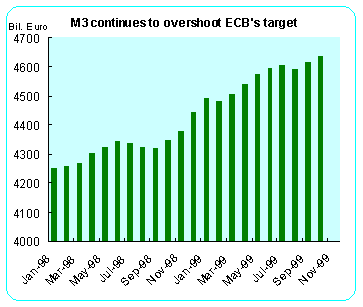
Other indicators November producer prices rose 0.1 percent on the month and were up 0.7 percent on the year indicating that price pressures continue to be subdued. The direct effects of higher oil prices in both producer and consumer prices appear under control, and the large import prices increases in recent months are not being passed on. Higher oil prices continue to account for much of the November price increase. Petroleum prices rose 2.6 percent on the month and 27.8 percent on the year. Excluding petroleum products, producer prices were unchanged in November and were down 0.3 percent on the year. The Bundesbank revised October industrial production data down significantly. The revised industrial output data show a 0.2 percent decline in contrast to the initially reported increase of 1.7 percent. The downward revision was mainly the result of strong upward revisions to the September and August index levels.
Italy  October unadjusted retail sales increased 3.1 percent when compared with last year, continuing the momentum after September's stronger than expected 2.8 percent gain. The October increase is due primarily to stronger sales in large stores, while food sales rose faster than nonfood. Since its retail sales data is not adjusted for price rises, it should continue to benefit from the increase in Italian inflation. Retail sales were particularly strong in the poorer southern regions, rising 4.1 percent. November preliminary producer prices jumped 0.5 percent on the month and 2.2 percent when compared to last year, once again driven higher by a surge in intermediate goods prices. The 2.2 percent jump was the highest since April 1996. The strong increases when compared with last year reflect in part, the very subdued PPI last year. This month's increase is practically all due to oil price pressures.
France September real retail sales dropped 2.8 percent in September, the third straight monthly decline. Monthly losses were concentrated among specialty retailers and food stores, while large department store sales were slightly higher. Third quarter retail sales were down 0.4 percent on the quarter, but still 3.2 percent higher on the year. The seasonally adjusted November unemployment rate declined to 10.8 percent, according to the ILO definition, which excludes job seekers who did any work during the month. The monthly declines were sharpest among job seekers under 25 years old (-2.8 percent), while the number for those over 50 fell by only 0.5 percent. The number out of work for over a year fell by 2.2 percent and was down 14.1 percent on the year.
Asia
South Korea
Japan November retail sales fell 2.8 percent on the year while wholesale sales fell 3.5 percent over the same period. Total sales fell 3.4 percent on the year while large scale retailers saw sales drop 4.1 percent, or 7.2 percent after adjusting for new stores and store closings. November seasonally adjusted unemployment declined to a 4.5 percent rate in November from 4.6 percent in October as more jobless people took temporary positions. The number of jobholders was unchanged from November of last year at 6.48 million, marking the first time in 22 months that the number did not fall from the previous year.
Americas 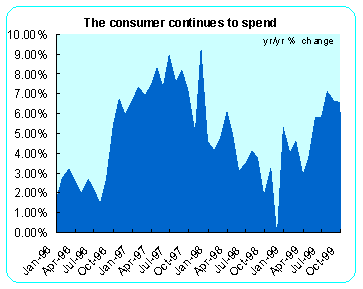 October gross domestic product at factor cost crept up only 0.1 percent because of auto related declines in manufacturing and softer retail sales. October's increase was the 15th consecutive month of growth, marking the longest uninterrupted series of gains in over a decade. Overall, 13 of 22 major industry groups, accounting for almost two-thirds of manufacturing output, curtailed production. Activity in the business services industry rose 0.8 percent, while construction activity rose 0.2 percent, buttressed by increased work on nonresidential projects.
End note...
Release dates are subject to change. | |||||||||||||||||||||||||||||||||||||||||||||||||||||||||||||||||||||||||||||||||||||||||||||||||||||||||||||||||||||||||||||||||||||||||||||||||||||||||||||||||||||||